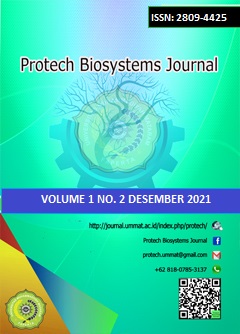Performance Analysis Of Vertical Type Mangosteen Skin Pressing Machine
DOI:
https://doi.org/10.31764/protech.v1i2.6783Keywords:
Performansi, Mesin Penepung, Kulit Buah Manggis, Analisis,Abstract
This study aims to determine the working mechanism of the vertical type mangosteen peel penepung machine, to determine the production capacity of the results of the performance analysis of the vertical type mangosteen peel penepung machine, to determine the electrical power requirements and to determine the efficiency of the machine the results of the performance analysis of the vertical type mangosteen peel penepung machine. The method used in this research is the Experimental method by conducting experiments in the Agricultural Workshop Lab. The design used is a Completely Randomised Design consisting of 3 treatments using a vertical type mangosteen peel penepung machine with load variations, namely, P1 = 50 grams, P2 = 100 grams, P3 = 150 grams using a 1400 rpm rotation. Each treatment was repeated 3 times so as to get 9 experimental units. The research data were analysed using load variations (Anova table) at the 5% level and if there was a treatment that had a significant effect, further tests were carried out using the Real Differential Test (BNJ) at the 5% real level. The results of the analysis and research show that the working mechanism of the machine uses an electric motor as a driving force, the highest mangosteen skin pressing capacity in P3 is 177.80 grams / second and the lowest in P1 80.82 grams / second, the use of the highest electrical power requirements in P3 0.17 watts and the lowest electrical power usage P1 is 0.09 watts and the efficiency of the machine in P1, P2 and P3 is the same at 53.33%.References
Adi, S . 2015. Teori Probabilitas. Salatiga. Tisara Grafika.
Amirin, T. M. 2010. Signifikansi :Penggunaan dan Analisa Data nya. Jakarta. Likers.
Azhar. 2007. Media Pembelajaran. Jakarta : Raja Grafindo Persada.
[BPS] Badan Pusat Statistik. 2020. Produksi tanaman buah-buahan[internet]. Tersediapada:https://www.bps.go.id/site/resultTab.
Coelli, TJ., DSP Rao, dan G.E. Battese. 1998. An Introduction to Efficiency and Productivity Analysis. Kluwer Academic Publisher, London.
Eiseman, F, and M. 1997. Fruit Of Bali. Periplus Editions (HK). Ltd., Hongkong.
Hariani S. 2014. Efektivitas ekstrak daun mundu (Garcinia dulcis)sebagai larvasi dan yamuk Culexquinquefasciatus dan Aedesaegypti [skripsi]. Bogor (ID): InstitutPertanian Bogor.
Hanafiah, N., 2009. Pengaruh konsentrasi NAA dan BAP terhadap pertumbuhan Eksplan jarak pagar (zat trop ha curcas L) secara ingfitro.skripsi fakultas Pertanian UNS.syurakarta
Hutapea, J.R. 1994.Inventaris tanaman obat Indonesia jilid III.Jakarta : Madya Cetradifa.
Jamal Y, Praptiwi, Agusta A. 2001. Penampisan fitokimia, ujitoksisitas dan anti bakteri dari ekstrak kulit batang G.celebicadan G. tetandra.Buletin Farmasi Indonesia.
Kementan RI. 2015. “Renstra Kementrian Pertanian Pertanian Tahun 2015 - 2019,†1–339. doi:351.077 Ind r.
Madury AS, Fakhrunnisa F, Amin A. 2012.Pemanfaatan kulitmanggis (Garcinia mangostana L) sebagai formulasi tabletanti kanker yang praktis dan ekonomis.Khazanah.
Mardiana, L. 2012. Ramuan dan Khasiat Kulit Manggis . (B. P. W., Ed): Jakarta. Penebar Swadaya.
McCall, R.B.,1970. : Fundamental Statistics for Psychology. New York : Harcourt, Brace &World, Inc.,
Miller, R. J and Meiners R. E., 2000.Teori Mikroekonomi Intermediate. Jakarta: PT. Raja Grafindo Persada.
Nicholson, W., 2002.Teori Mikroekonomi Intermediate, Terjemahan. Jakarta: PT. Raja Grafindo Persada.
Novitasari, 2013.Pendekatan Goal Programming Dalam Perencanaan Produksi. Jurnal Mahasiswa Matematika, (online), (http://matematika.studentjournal.ub.ac.id), diakses tanggal 15 Desember 2019.
Pantastico, E.B. 1989. Faktor-faktor Prapanen yang Mempengaruhi Mutu dan Fisiologi Pascapanen.dalamFisiologi Pasca Panen Penanganan dan Pemanfaatan Buah-buahan dan Sayur-sayuranTropika dan Subtropika editor Er.B.Pantastico.terjemahan Kamariyani.Gajah mada universityPress.Yokyakarta.
Pasaribu, F., P. Sitorus, dan S Bahri. 2012. Uji ekstrak ethanol kulit buah manggis (Gracia Mangostana L) terhadap penurunan kadar glukosa darah. Jurnal of pharmaceutics dan pharmacology.
Purwanto A. 2002. Kajian macam eksplan dan konsentrasiiba terhadap multiplikasi tanaman manggis (Garcinia mangsotana L.) secara invitro [skripsi]. Surakarta (ID): Universitas Sebelas Maret.
Pongpaichit S, Rungjindamai N, Rukachaisirikul V, Sakayaroj J. 2006.Antimicrobial activity inculturesof endophytic fungiisolated from Garcinia species. FEMS Immunol MedMicrobiol.
Rahayu dan Endang S. 2012. Teknologi proses Pengolahan Tahu.Yogyakarta. Kanisius.
Rukmana R. 1994. Budidaya Manggis. Yogyakarta.Kanisisus.
Shinta, A., 2005. Ilmu Usahatani. Fakultas Pertanian Universitas Brawijaya press, Malang.
Soekartawi, 2000.Agribisnis, Teori dan Aplikasinya, Cetakan ke-6, PT. Grafindo Persada, Jakarta.
Soekartawi, 2002.Prinsip Dasar Ekonomi Pertanian Teori dan Aplikasi. PT Raja Grafindo Persada, Jakarta.
Sumayang, L., 2003. Dasar – dasar Manajemen Produksi dan Operasi, Edisi pertama, Jakarta: Salemba Empat Patris.
Sulassih, Sobir, Santosa E. 2013. Phylogenetic analysis ofmangosteen (Garcinia mangostana L.) and itsrelatives basedon morphological and inter simple sequence repeat (ISSR)markers. SABRAO Journal of Breeding and Genetics.
Sutardi A., dan Budiasih, E., 2007. Sediakan Dan Hitung Stock Agar Tak Kehilangan Konsumen, Elex Media Komputindo, Jakarta.
Suyanti.Roosmani ABST dan Sjaifullah.1999.Karakterisasi Sifat Fisik dan Kimia Buah Manggis dari Beberapa Cara Panen. J. Hort. 6(5):492-505.
Tjitrosoepomo, G. 1994. Morfologi Tumbuhan. Gajah Mada. University Press.Yogyakaarta.
Tjondronegoro, P. 1999. Dasar-dasar Fisiologi Tanaman Jilid II. Gramedia Pustaka Utama. Jakarta
Verheij EWM, Coronel RE. 1997. Sumber Daya Nabati AsiaTenggara 2: Buah-buahan yang dapat Dimakan. DanimihardjaS, Sutarno H, Utami NW, Hoesen DSH, penerjemah; VerheijEWM, Coronel RE, editor. Jakarta (ID): Gramedia PustakaUtama. Terjemahan dari: Plant Resources of South East Asia2: Edible Fruits and Nuts.
Willmer CM. 1981. Stomata. London (UK): Longman Group Ltd.
Downloads
Published
Issue
Section
License
Authors who publish articles in Protech Biosystems Journal agree to the following terms:
- Authors retain copyright of the article and grant the journal right of first publication with the work simultaneously licensed under a CC-BY-SA or The Creative Commons Attribution–ShareAlike License.
- Authors are able to enter into separate, additional contractual arrangements for the non-exclusive distribution of the journal's published version of the work (e.g., post it to an institutional repository or publish it in a book), with an acknowledgment of its initial publication in this journal.
- Authors are permitted and encouraged to post their work online (e.g., in institutional repositories or on their website) prior to and during the submission process, as it can lead to productive exchanges, as well as earlier and greater citation of published work (See The Effect of Open Access).

